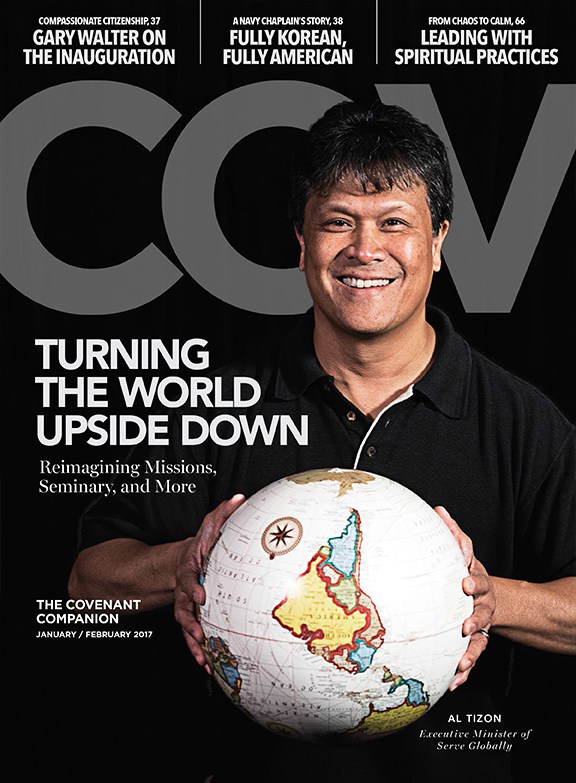
By Steve Burger
In our congregation we have discovered that worship requires the presence, engagement, and voice of every generation.
A mother and son read Scripture together. A four-year-old leads the congregation in the Lord’s Prayer. A senior member sits to offer a testimony. Teens, adults, and children are invited forward for an impromptu drama. A family with a son on the autism spectrum shares the biblical passage using shadow puppets. All to the glory of God.
Intergenerational worship provides a sense of belonging both to Christ and to each other.
It is the entire body of Christ focused on God, attentive to the Spirit, acknowledging and celebrating Christ as Lord and Savior. All generations present, engaged, having voice, and collectively seeking the voice of God.
Without this experience together we lack both a shared story and a cohesive and shared identity as the body of Christ. Intergenerational worship moves us from an institutional perspective (What do I belong to? What services do “you” provide?) to a body life perspective (Who is Christ calling “us” to be and do? To whom do “we” belong?).
In our congregation at DeerGrove Covenant Church in Palatine, Illinois, we have discovered that worship requires the presence, engagement, and voice of every generation.
Presence
In 1 Corinthians 12, Paul makes clear that Christ’s body is made up of many different parts but all are needed and all are indispensible. It’s difficult to function as a body when not all the members are present with one another. “Place” is important to all of us and especially to children. Place establishes a sense of belonging and the form within the space further clarifies both the purpose of the place as well as a person’s place within it.
No matter what the physical structure looks like, it is important to be intentional about how we use it to invite presence.
We are fortunate at DeerGrove to be on one level, so the worship space is easily accessible to everyone. We don’t have pews. Rather, we have a variety of seating and spaces for the purpose of welcoming all into the presence of God and into the body of Christ. There are rows of chairs that can be easily moved to make room for a wheelchair or walker. In our worship space we have high tables and chairs toward the back for families with children who need space to create. We also have couches for families with small children and for children on the autism spectrum who need a place to pace or move around in the context of worship.
The nursery is right off the back of the sanctuary for easy accessibility. There is no raised area at the front—and if there were, we would avoid calling it a “stage.” Words are important, especially to children. The word stage denotes performance, in which the people on the stage are the focus. Yet we know that God is our focus and everyone is on the same plane. Everyone has access to every part of the sanctuary and everyone is invited to be present. This is why our preparation and practices begin first with prayer and personal reflection on our continuing journey with Christ. We recognize that every moment is a moment with God, a moment of worship if we are attentive to God’s Spirit.
Not every church facility can offer these options. First and foremost is the intentionality and invitation of being present with God and each other and giving consideration to what the accessibility of our space says about who is welcome and who is invited to belong.
Engagement
We recognize that every generation and every person do not engage in worship the same way. Yet we have found that historically common elements of worship are engaging for all generations—especially for children as it helps them to live the story rather than just hear it.
For example, calls to worship, the Doxology, the Gloria Patria, and responsive pieces of music are all things young children learn through repetition. And children can engage in each of these elements before they can read. Prayers of thanksgiving and intercession, as well as space for silent prayers of confession and words of assurance, help everyone to actively live into the unfolding story of the gospel every week.
Prayerfully entering into the reading of the Old and New Testament gives focus to the word apart from the sermon and makes space for the Spirit to enlighten the reader and listener.
Music throughout worship rather than in one large chunk gives everyone opportunity for movement. When used amidst prayer, offering, and the reading of the word, music gives context to our vocal response and praise. In our congregation we also provide printed copies of the words to the songs we sing for those who may not be able to see the screen.
Worship is an active and intentional expression of our devotion to God. Sometimes this occurs through prayer, reading, and singing, but it can also take place through drama, spiritual practices, and worship stations. After communion our congregation moves to other places in the sanctuary where a window is set up on a table, and we are invited to consider how we view the world, and how God views it. Or we look into a mirror and consider how we see ourselves and how God sees us. In November, we pack Thanksgiving baskets during worship. These elements provide both vertical and horizontal expressions of worship—a sense of both the holiness of God and the gracious tangible presence of God.
Often during the sermon our pastor, Melissa Wall, invites people from the congregation forward for impromptu dramatic illustrations. When a variety of generations are engaged in a drama, a greater portion of the body can both identify with and enter into the story. And when she includes these in her message it also helps to engage all generations visually as well as audibly.
Voice
In our church children, youth, and adults all serve as worship leaders. Giving voice to all generations is an easy way to engage the entire body of Christ. Every generation reads Scripture, leads prayer, participates in drama, and serves on the music worship team and as ushers and greeters.
During Advent, all the children lead us into worship carrying lighted lanterns, kneeling in front of the manger and cross for a moment of silence to ready our hearts for the Spirit’s leading. During Lent, children (or a variety of generations) carry in candles (light of Christ), palms (Christ our King), a crown (Christ’s sacrifice), ashes (our sinfulness and Christ’s sacrifice), and a candle (hope of Christ in the resurrection). These items are placed before the cross and we enter into a moment of silence, remembering the story and contemplating our place in it. This is movement prayer—prayer without words but whose movements engage us. Every child, youth, and adult knows that when they serve in this capacity the focus is on God.
Presence of Children
Children are present in our worship service every week. We provide a nursery for the youngest members. The rest of the children are with their families or spiritual families for worship except for twenty to twenty-five minutes during the sermon.
Just before the sermon children are “invited” (never “dismissed”) to participate in exploring the same biblical passage that is being preached. Before they leave, the children gather and bless the congregation with the words “The Lord be with you.” The congregation responds by saying, “And also with you.” During their time together the children are given opportunity to prepare a response to the Bible story. When they re-enter the sanctuary during the responsive hymn, they process to the front and share their responses to the passage with the congregation. Then they rejoin their families.
On communion Sundays children over the age of three remain in the service for an interactive message. When we enter into communion families pick up their children from the nursery and young children’s room. We come forward as an entire body, and children who are not yet ready to receive communion receive a blessing.
This is worship that is intergenerational. We live into it by living first in God, collectively surrendering ourselves to Christ, prayerfully coming together across generations, and seeking the direction of the Spirit. It’s a journey, not a playbook, time together with God, focused on God and shaping our story and identity as Christ’s body. Worship.
Be sure to check out Incorporating Children in Worship, by Michelle A. Clifton-Soderstrom and David D. Bjorlin, for a thoughtful reflection on why children have a place at the center of the life of the church—and how their full participation in worship enriches the church in distinct ways (Cascade Books, 166 pages).
Steve Burger works in children, family, and intergenerational ministry for the ECC. He has a profound memory of God’s loving presence throughout his childhood, and today he still experiences a powerful sense of the Spirit’s presence when he is with children.



I pastor a small church that is making strides to get the generations mutually involved with one another. Why? Because the evidence is strong that kids growing up in a truly intergenerational faith environment stand a better chance of continuing with their faith as young adults than kids who grow up in highly segregated faith environments. So our church has the intention of interweaving the generations, but we don’t always have the know-how. Strong working models are in short supply. That’s why I love this article. It opens up all sorts of new ideas and possibilities. Many thanks, Steve!